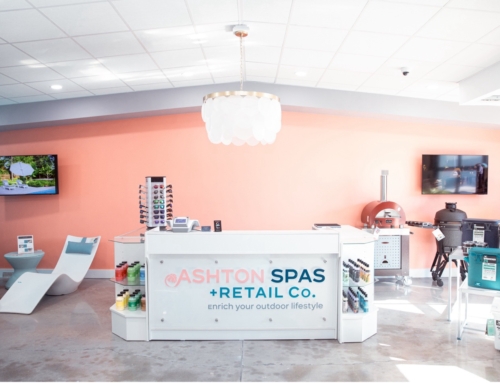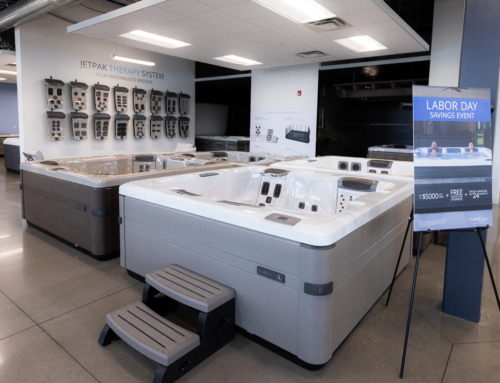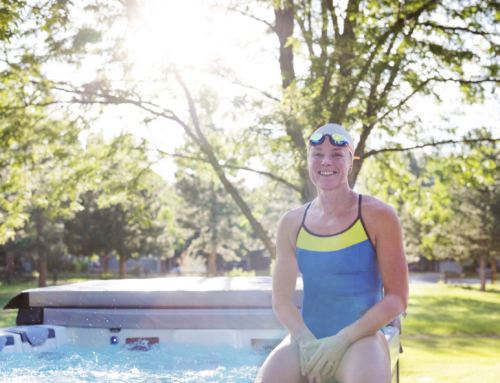Most hot tub retailers would probably agree that advertising is an important way to reach consumers and that sales and special offers are an effective way to get them into your store. The question becomes how to best accomplish this, especially in today’s ultra-competitive ad space.
It isn’t really that difficult though if you have a checklist of essentials to work from when putting an ad together. Your job as a retailer is to ensure that each piece of advertising contains the right elements—elements that are proven to get customers into your store. There are, in fact, six elements of effective ad messaging. Let’s take a look.
1. Logo Identification
Your logo serves as the graphical representation of your company. It’s extremely important that the logo is clearly visible and uniquely designed so that potential customers immediately associate it with your business. A strong, clear logo answers the question, “Who are you advertising?” The answer is, of course, your business. In fact, an article in the small business section of the Houston Chronical points out that “a logo anchors a company’s brand and becomes the single most visible manifestation of the company within the target market.”
Users are 89% more likely to remember logos shown in the traditional top-left position than logos placed on the right.
So, where should your logo appear in the advertisement? Common sense says to place it in the upper left-hand corner of your ad because people naturally read from left to right. A recent Nielson-Norman Group study of web advertising showed that “Users are 89% more likely to remember logos shown in the traditional top-left position than logos placed on the right.” It makes sense that this would hold true for traditional print advertising as well.
Logo design is also an important part of identification and should remain consistent across advertising venues. Having several different versions of your logo can be a distinct disadvantage in that even small differences like font choices can make it difficult for potential buyers to associate two logos with one business. You’ll also want to make sure your logo is recognizable wherever it appears, be it in a newspaper, on letterhead, on delivery vehicles, or on a webpage. It should also be recognizable in both black and white and color. Consulting a professional logo designer can ensure you get the most from brand identification in your ads.
2. Products/Service Statement
A product/service statement explains what your product is and why it’s valuable to consumers. The key to an effective product statement is to sell benefits over features. Features are the hot tub facts you want the customer to know about, while benefits show customers what’s in it for them.
Benefits are what will bring the customer into the store, and once they come in and see the product, the features serve as icing on the cake.
Let’s say you’re store is having a Spring Fling sale on last year’s hot tub models to make room for new ones. Your advertisement should highlight the benefits to the customer first:
- Stress relief
- Improved health
- Quality together time
- Financing
- Free delivery
Benefits are what will bring the customer into the store, and once they come in and see the product, the features serve as icing on the cake.
According to Brand Balm, you can also turn features into benefits with a “so what?” test. Say one feature you want to highlight is adjustable jets. You might write a statement like “Complete with state-of-the-art adjustable jets” in your advertisement. The customer reads this and thinks “so what? What do these jets do for me?” Incorporating the answer into the original statement turns a feature into a benefit as “Complete with state-of-the-art adjustable jets” becomes “Complete with adjustable jets for maximum pain relief.”
3. Value Impression
Why should customers buy from you instead of someone else? That is the question a value impression answers in your advertising campaign. Consumers need to know what makes your product a better value than the competition’s products. This is where you can emphasize the unique features of your product. In fact, it’s a great place to mention:
- that your hot tubs come with the longest, strongest warranties in the industry
- that your company offers competitive interest rates on financing compared to other dealers in town
- that your store offers a complete line of hot tub accessories and service plans at affordable prices
Value impressions show the reader how they can get more for their money at your store than they can from your competitors.
4. Tie Breaker
A tie breaker is a differentiating statement designed to convince customers that your product is more desirable than another. Prosper-Strategies highlights three keys to a strong differentiating statement:
- It needs to align with why customers choose you over the competition.
- It needs to relate to a specific feature or benefit that distinguishes you from the competition.
- It must be believable.
A tie breaking statement for a hot tub retailer might look something like this:
Henry’s Hot Tubs is the only spa retailer in Somewhere, USA whose entire service team is APSP certified.
The key is to discover the one thing that sets you apart from other retailers and use it to win over customers who may be on the fence in deciding where to purchase their home spa.
5. Urgency Date
When you’re advertising a sale, the urgency date lets the customer know that the offer has an expiration date and makes sure they know what that date is. Prominent placement of deadlines provide a sense of urgency (hence the name urgency date) designed to entice customers into your store. The date that the sale or event will end is important, but so are statements designed to emphasize why the customer needs to come in before the offer expires.
The date that the sale or event will end is important, but so are statements designed to emphasize why the customer needs to come in before the offer expires.
Here are just a few ways to create a sense of urgency in your advertising:
- Time Restrictions: “This weekend only!”
- Limited Quantities: “While supplies last!”
- One Day Events: “Get 25% off at our annual St. Patrick’s Day extravaganza!”
- Contests: “The first 25 customers receive a limited edition water bottle” or “Enter to win free delivery of your new spa!”
Incorporate phrases like “Act now” and “For a limited time only” to get customers act on your advertising.
6. Locator
Last but not least, you must include information on how potential buyers can find your company or store. Include the street address, the hours of operation, telephone numbers, e-mail addresses, and website information when appropriate.
In the end…
An Aqua Magazine article states that “your ads must be smart, creative and well-placed to reach your desired market and make them want what you sell.” In the end it’s about brevity, focus, and perception: Short advertisements that focus on specific offers and that customers will perceive as being of personal benefit to themselves.









Nice article. Never realized the importance of logo placement! Mike, Lake Havasu City, Arizona.